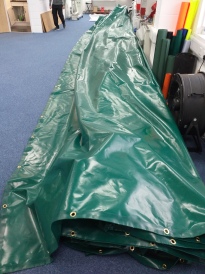Tarpaulins are very common nowadays. Tarpaulin has gained in popularity because it is flexible to use and is virtually weatherproof. Not all tarpaulin materials are weatherproof, though most of them are flexible. For example, canvas is a good cover against the heat but it’s not really water resistant so it might get wet one way or another. Woven Polyethylene is the most common type of Tarpaulin, these are woven and then laminated, the lamination is the thin clear film put over the weave to make sure it is watertight. Some cheaper polyethylene tarps are only laminated on one side so even a scratch can damage their surface and let water through. Polyester reinforced PVC tarpaulins, like the ones we make here at allplas.co.uk are 100% waterproof and can put up with all sorts of wear and tear. These are a closely woven polyester weave that is then homogeneously covered or dipped in PVC to create one single and un-separable sheet. Available in a great range of colours and suitable for almost all environments.
Aside from different materials, tarpaulins can also be classified according to their thickness. A lightweight tarp is said to be between 65 – 100 grammes per square metre. Ours are 100gsm and available in Olive Green or Natural. Natural is a translucent white that lets lots of light through. A heavy duty tarp is 610 grammes per square metre. Just like with their different thickness, the heavier the gsm, the better the tarp will last.
Probably the best way to work out what tarp you need is to ascertain firstly how long you need it for and whether you want to reuse it. Will it be put over something that could wear through a light one quite easily. Is it in a sheltered environment or on something like a boat and finally do you want one a particular size with eyelets closer than the standard bought sheets.
In an exposed environment over an object with fairly sharp corners, do not buy a cheap or light tarp, it will not last you anytime at all. If you do have a cheap lightweight sheet under these types of conditions, cover any sharp surfaces with a piece of cardboard or another piece of plastic to stop the chafing. Also once tied down, put some additional rope over the sheet as the eyelets are sure to pull loose.
Use one of our 610gsm polyester reinforced PVC Tarpaulins and you can choose from a great range of colours, we will put solid brass eyelets in all the way round at 500mm spacings and of course in the four corners, we will make it to whatever size you want and deliver it in a couple of working days.



Pingback: Fast turn around | Best Tarpaulin Blog